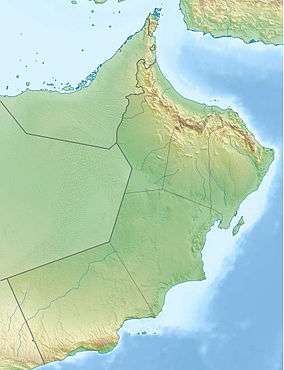Archaeological Sites of Bat, Al-Khutm and Al-Ayn
The Archaeological Sites of Bat, Al-Khutm and Al-Ayn[1] are a group of necropolises from the 3rd Millennium BC, located near a palm grove. They were declared World Heritage by UNESCO in 1988[2].
| UNESCO World Heritage Site | |
|---|---|
Burial mound at the site of Al-Ayn. | |
| Location | Al Dhahira region, Oman |
| Includes |
|
| Criteria | Cultural: (iii), (iv) |
| Reference | 434 |
| Inscription | 1988 (12th session) |
| Coordinates | 23°16′11.5″N 56°44′42″E |
 Location of Archaeological Sites of Bat, Al-Khutm and Al-Ayn in Oman | |
Description
Studies during the last 15 years have shown the existence of numerous human settlements ranging from the Persian Gulf to the Gulf of Oman.
Bat
The site of Bat is located inside a palm grove. Around 3000 BC there was an intense trade of copper (extracted locally) and stone (probably diorite) with Sumerians.[3] The necropolis consists of 100 graves and circular buildings each with a diameter of about 20 meters. These buildings have no outside openings, so besides the possibility of their ritualistic function, they may have been used as tanks or silos. Their precise function is as of yet unknown. In 1972, the excavations carried out by a Danish team led by Karen Frifelt showed that the area has been continuously inhabited for 4000 years.
Al-Khutm
The ruins at Al-Khutm are thought to have derived from a stone fort, with a tower made of rock with a diameter of 20 metres (66 feet). They are located 2 kilometres (1.2 miles) west of Bat.
Al-Ayn
Al-Ayn is a small necropolis, although it is in the best condition of the three necropolises. It is located 22 kilometres (14 miles) southeast of Bat.[4]
Conservation
The sites have not been subjected to restoration or other types of conservation before the protection provided by UNESCO, so their isolation has been their only protection. One of the greatest dangers concerning the sites preservation comes from locals who take building material from the archaeological sites.[3]
See also
- Al Ain, a city with archaeological sites in the United Arab Emirates
- Al-Buraimi
- Hafit period
- Ibri
- Jebel Hafit
- Umm al-Nar culture
References
- Christopher P. Thornton; Charlotte M. Cable; Gregory L. Possehl (2016). The Bronze Age Towers at Bat, Sultanate of Oman. University of Pennsylvania Press, Inc. pp. i–vi. doi:10.2307/j.ctv2t4ct6.1. ISBN 978-1-9345-3607-0.
- UNESCO page of Archaeological Sites of Bat, Al-Khutm and Al-Ayn
- Evaluation Advisory Body of UNESCO
- Dekanovsky, Vaclav (29 February 2020). "Articles about Al Ayn". The Travel Holiday.